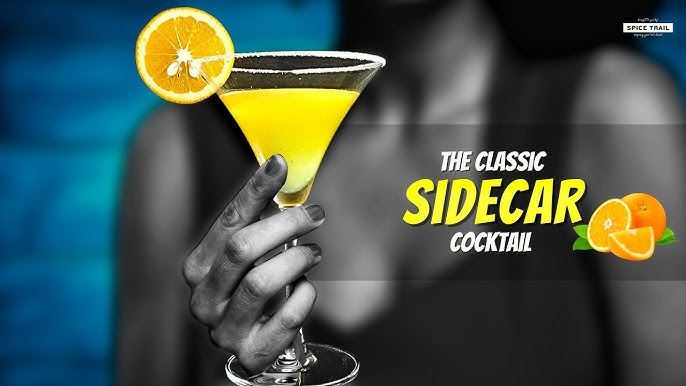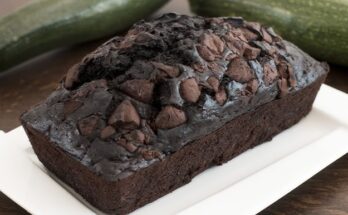Sidecar Cocktail Recipe: The Sidecar cocktail is one of those drinks that carries a bit of mystery, a whole lot of class, and a timeless elegance that appeals to both new and seasoned cocktail lovers. Born in the early 20th century, it’s a cocktail that has truly stood the test of time, not just because of its simple yet refined taste, but because of how perfectly balanced it is.
A Brief History of the Sidecar
The origins of the Sidecar are a bit fuzzy—like most great stories that involve alcohol. It’s widely believed to have been created sometime after World War I, either in Paris or London. The Ritz Hotel in Paris often gets credit, but so does a London bar patron known for arriving in a motorcycle sidecar—hence the name. The cocktail gained fame quickly and became a staple in high-end bars throughout Europe and the United States.
Its composition—cognac, orange liqueur, and lemon juice—makes it both zesty and warming. Over time, bartenders tweaked the recipe slightly, but the core has remained consistent. It’s one of the few drinks from the Prohibition era that never lost popularity.
Why the Sidecar Stands Out
There’s something about the Sidecar that feels effortlessly elegant. It’s not overly sweet, not too sour, and doesn’t drown in its alcohol content. The citrus from the lemon juice wakes up your palate, while the cognac offers a deep, velvety base. The orange liqueur adds that hint of warmth and sweetness to round it all off.
It’s also versatile—perfect as a pre-dinner drink, great for impressing guests, or even just treating yourself on a chill evening. If you’re looking to level up your cocktail game, this one is a must-learn.
Ingredients Needed for a Classic Sidecar
Crafting the perfect Sidecar starts with understanding what goes into it. There are only a few ingredients, which means each one really matters. Don’t skimp here—quality makes all the difference.
Core Ingredients Explained
Here’s what you need:
- 2 oz Cognac (or Brandy) – The heart of the drink. Cognac is smoother and richer, but a good quality brandy also works.
- 1 oz Orange Liqueur – Cointreau is the go-to choice. It’s dry, crisp, and balances the cocktail beautifully.
- ¾ oz Fresh Lemon Juice – Fresh is key. Bottled lemon juice won’t give you that sharp, bright citrus flavor.
- Sugar for rimming (optional) – Adds a touch of sweetness, especially if you prefer a less tart drink.
- Ice – You’ll need this for shaking.
That’s it—simple, but every element plays a big role in flavor balance.
Best Brands to Use
- Cognac: Hennessy VS, Rémy Martin VSOP, or Courvoisier VS
- Orange Liqueur: Cointreau, Grand Marnier (a richer version), or Triple Sec if you’re on a budget
- Lemon Juice: Always use fresh lemons and squeeze just before use
These choices can elevate your cocktail from decent to bar-quality. If you’re new to mixing drinks, it’s worth investing in a couple of these staples—you’ll use them often.
Tools and Glassware You’ll Need
Let’s talk gear. Making a Sidecar doesn’t require a full bar setup, but a few basic tools can really streamline the process.
Essential Bartending Tools
- Cocktail shaker – A Boston shaker or a cobbler shaker works well.
- Jigger – For accurate measuring of your ingredients.
- Strainer – A Hawthorne strainer is ideal.
- Citrus juicer – A handheld one gets the most out of your lemon.
- Bar spoon – For stirring or adjusting ingredients if needed.
You don’t need a fancy bar cart. Just these tools and you’re good to go.
Choosing the Right Glass
Traditionally, the Sidecar is served in a cocktail glass or coupe glass. These have a wide mouth, allowing the aromas to reach your nose as you sip. The stem keeps your hand from warming the drink, which is served straight up (no ice).
Want to go full classic? Chill your glass in the freezer for about 10 minutes before pouring the drink in.
How to Make the Perfect Sidecar – Step-by-Step
Let’s get to the fun part—actually mixing your cocktail. Here’s how to do it right every single time.
Step 1: Preparing Your Ingredients
- Juice the lemon – Fresh juice only. You’ll need about ¾ oz.
- Measure your liquor – 2 oz Cognac and 1 oz Cointreau or orange liqueur.
Line everything up before you start. It makes mixing smoother and more precise.
Step 2: Mixing the Cocktail
- Add ice to your cocktail shaker (about two-thirds full).
- Pour in the cognac, orange liqueur, and lemon juice using your jigger.
- Secure the shaker lid and shake vigorously for 15–20 seconds. You want a nice chill on the drink and a good blend of ingredients.
Step 3: Chilling and Straining
- Optional: If you’re going for a sugar-rimmed glass, rub a lemon wedge around the rim and dip it in sugar before pouring.
- Take your chilled coupe glass out of the freezer.
- Use the strainer to pour your cocktail into the glass—no ice.
Step 4: Garnishing the Drink
A classic Sidecar doesn’t need much. You can go completely garnish-free or:
- Add a lemon twist on the rim
- Drop in a thin orange peel for aroma
And there you have it—your perfect Sidecar, ready to sip.
Tips for the Perfect Sidecar Every Time
Nailing a Sidecar is all about balance. This cocktail may have just three main ingredients, but how you combine them makes a world of difference.
Balancing Flavors
- Taste Before You Serve: After shaking, give it a tiny taste before straining. Need more sweetness? Add a touch more orange liqueur. Too sweet? A splash more lemon juice will balance it.
- Quality over Quantity: Use premium ingredients. A low-end cognac or artificial lemon juice can really flatten the flavor.
- Fresh Juice is Key: Bottled lemon juice can make your cocktail taste dull and acidic. Freshly squeezed lemons add brightness and natural tartness.
Mistakes to Avoid
- Over-shaking or under-shaking: You need to shake it just enough to chill and dilute slightly. Too little and it’s too strong. Too much and it becomes watery.
- Warm glassware: Always chill your glass. A warm glass will warm the drink, killing the refreshing edge.
- Using cheap triple sec: If you’re not using Cointreau or a quality liqueur, your cocktail may come out tasting overly sweet or artificial.
Think of the Sidecar like a luxury car—it needs fine-tuned parts to perform well. Treat it right, and it will reward you with a smooth, punchy, citrus-forward experience.
Variations of the Classic Sidecar
While the classic Sidecar is delicious on its own, it’s also incredibly versatile. A few tweaks and you’ve got a whole new cocktail vibe.
Brandy vs Cognac Sidecar
The original calls for cognac, a type of brandy that hails from France. It’s smoother, fruitier, and offers a more refined flavor. But don’t worry—if you don’t have cognac, regular brandy works just fine.
- Cognac Sidecar: Rich, smooth, a bit floral.
- Brandy Sidecar: Slightly sharper, more earthy.
Try both and see which you prefer. Cognac elevates it, but brandy can give it a little extra punch and rustic charm.
Fruit-Infused Versions
Want to mix things up? Here are a few tasty twists:
- Raspberry Sidecar: Muddle 4-5 raspberries in the shaker before adding other ingredients.
- Blood Orange Sidecar: Swap out lemon juice for blood orange juice for a sweeter, darker tone.
- Ginger Sidecar: Add a small splash of ginger liqueur for some spicy depth.
Each variation has its own personality. The fruit adds a modern flair, while still letting the base shine through.
Food Pairings with a Sidecar Cocktail
You’ve got your cocktail, now what to eat with it? The Sidecar’s citrusy sharpness and smooth finish pair beautifully with a variety of foods.
Here are some top pairing ideas:
- Charcuterie boards: Cured meats, sharp cheeses, and a few olives are perfect companions.
- Duck or poultry dishes: The citrus notes in the Sidecar cut through the richness of roasted meats.
- Seafood platters: Think oysters, crab cakes, or grilled shrimp.
- Desserts with citrus or spice: Lemon tarts, ginger cookies, or spiced cakes can contrast or complement the cocktail’s flavor.
Because it’s a versatile drink, the Sidecar can swing both ways—sharp enough to slice through fatty dishes, but smooth enough to pair with sweets. Experiment and find your favorite match.
FAQs about Sidecar Cocktail Recipe
What is a Sidecar cocktail?
The Sidecar is a classic cocktail traditionally made with cognac, orange liqueur, and lemon juice. Known for its smooth yet tangy flavor profile, it’s considered one of the quintessential drinks of the cocktail world, embodying a perfect balance of sweet and sour.
What ingredients are needed to make a Sidecar cocktail?
To whip up a Sidecar, you’ll need the following ingredients:
- Cognac: The base spirit that gives the cocktail its robust flavor.
- Orange liqueur: Typically Cointreau or triple sec, adding a crisp citrus sweetness.
- Lemon juice: Freshly squeezed for that essential zesty kick.
How do I make a Sidecar cocktail?
Making a Sidecar is straightforward:
- Measure the Ingredients: Combine 2 ounces of cognac, 1 ounce of orange liqueur, and ¾ ounce of lemon juice.
- Shake: Add the ingredients to a cocktail shaker filled with ice and shake vigorously until well-chilled.
- Strain and Serve: Strain into a chilled cocktail glass. Optionally, rim the glass with sugar beforehand for an extra touch of sweetness.
What is the best cognac for a Sidecar?
While any quality cognac will work, VS or VSOP grades are commonly recommended for their smoothness and flavor depth without overshadowing the other ingredients.
Can I substitute other spirits in a Sidecar?
Traditionally, the Sidecar is made with cognac, but variations can include using bourbon or whiskey for a different twist on the classic. Each substitute brings a unique flavor profile, making the cocktail versatile and personalizable.
Is the Sidecar cocktail strong?
Yes, the Sidecar is considered a strong cocktail due to its high proportion of spirit (cognac) to non-alcoholic mixer (orange liqueur and lemon juice). It’s a potent drink with a sophisticated edge, perfect for sipping slowly.
What is the origin of the Sidecar cocktail?
The Sidecar is believed to have been invented around the end of World War I in either London or Paris. The drink was purportedly named after the motorcycle sidecar that the American army captain, who created the cocktail, rode in.
Conclusion
The Sidecar cocktail is a timeless blend of sophistication, simplicity, and stunning flavor. Whether you’re a cocktail novice or a seasoned home bartender, learning to master this classic drink will elevate your mixology game instantly. With just three core ingredients and a few bar tools, you can craft a drink that’s zesty, smooth, and packed with personality.
It’s more than just a cocktail—it’s a vibe. So next time you’re hosting friends, treating yourself, or just want a taste of the Roaring Twenties with a modern twist, go for a Sidecar. And remember, the magic is in the balance, the quality of your ingredients, and the care you take in mixing.
Cheers to your next perfect pour!



